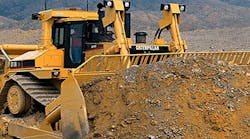Craig Bouchard, chairman of Board of Signature Group Holdings, and former CEO of Esmark, was quite surprised to be writing about Caterpillar (IW 500/18).
His intention was to help two groups of U.S. citizens; the ones who had lost their jobs and were thinking about starting a business and the ones who had jobs but saw their 401(k) investments tank.
The common denominator for these two groups is the quality of management. In the first group the issue is how to create successful companies and in the second group the issue was why the investment strategy did not consider the success rate of the companies selected for the mutual funds in the 401(k).
Looking at a variety of companies-- including Boeing, GE, Exxon, Coca-Cola and Apple -- Caterpillar kept showing up at the top of the list.
Once Craig and co-author James Koch decided to pursue Caterpillar’s story of how they went from losing $1 million per day in the 1980s to current sales which are 1.9 times as large as its nearest competitor, getting Caterpillar’s management to sit for interviews was no small feat. But at the end of the day Caterpillar had a good story and was happy to tell it.
“Caterpillar has met the market test better than has any other large industrial firm in the U.S.,” Bouchard writes in his book The Caterpillar Way (ranked #8 on the NYT Business Bestseller List ). Its ability to scale its size and performance upward is a remarkable story, as is its ability to cope with economic recession. Getting better as they got bigger is why Bouchard believes studying this company could help other companies.
In order to grow, U.S. companies must pursue global customers, but how they achieve this is tricky. Caterpillar decided to compete as a local company in a foreign market and that has been their success.
In 2002 under then CEO Glen Barton, Caterpillar announced a goal of achieving $30 billion in revenue along with a 10% companywide cost savings which was to translate into $1 billion in cost savings while improving quality and reliability. Dealers and customers were part of this plan as well. This was the beginning of the company’s journey into Six Sigma.
Looking more closely at the underpinings of the strategies behind the success the authors created a model of 25 criteria called the Bouchard-Koch Scale Efficiency Model.
A Closer Look at What CAT is Doing Right
Bouchard talked with IW about the top criteria on this list.
The most important criterion concerned financial matters, specifically cash flow. The principle is to allocate capital throughout the firm to its highest and best use. This is a problem for many companies as current accounting systems don’t allow for this type of analysis, explains Bouchard.
Caterpillar however did a good job of unearthing this information and allocating both fixed and variable costs in a way that managers could easily see if they were making or losing money. With increased transparency they were also able to get better prices on tasks that often were performed internally at higher costs.
Once informed they were able to place capital in areas that achieved the greatest return. Evidence of success is that in the time period from Jan. 2, 2001 until Jan. 2, 2013, the company’s stock price rose 433% while the S&P 500 increased only 12.3% during that same time.
Another criterion is the ability to create a process to negotiate labor contracts. Analzying Caterpillar’s labor relations evolution, Bouchard says that in talking with Caterpillar’s employees, the “overriding concern of the company in labor negotiations is to ensure that the company is globally competitive.
Employee compensation is only one part of this equation but is perhaps the most visible that the company can influence to achieve cost competitiveness in the global markets in which it earns 70% of its sales revenues.”
Quality is yet another factor that is ultimately the factor most responsible for success. The authors suggest fostering a culture of just-in-time delivery and service quality.
In addition to quality and Six Sigma the biggest gamble that Caterpillar took was its creation of “The Plant with a Future." In 1986, at a time when the company was losing money, CEO George Schaefer announced he was investing in a $1.8 billion plant modernization plan. “His vision was to build Caterpillar plants that would be so modern and efficient that CAT would beat Komatsu as its own game,” writes Bouchard. And by 1992 the company saw a 20% rate of return on capital invested in this plan which had four main components:
- Just-in-time inventory control systems
- Automation of factories
- Computerization and networking of machine tools on assembly lines
- Flexible manufacturing systems
“The Plant with a Future, does not receive the credit it deserves as a vital link in the chain of management decisions that together saved the company,” writes Bouchard.
It is the company’s mastery of the criteria discussed here as well as other points on the authors’ list of 25, that have enabled Caterpillar to achieve the success it enjoys today and will continue to enjoy in the future.
“The ultimate measure of success,” Bouchard explains, “ is the ability of a company to deliver exceptional returns for stockholders even while it treats other stakeholders – such as its employees and its community – equitable and prepares for the future."
To learn more about the book visit The Caterpillar Way.




